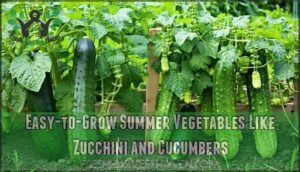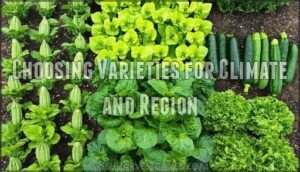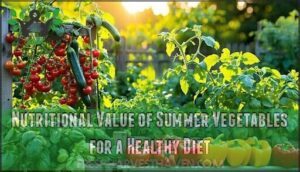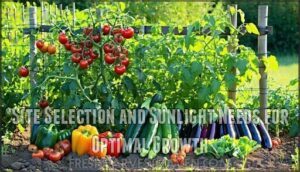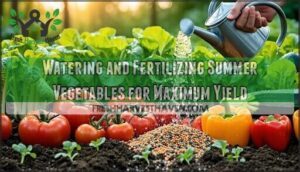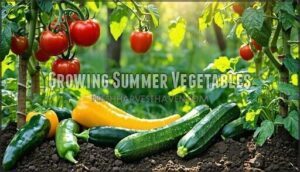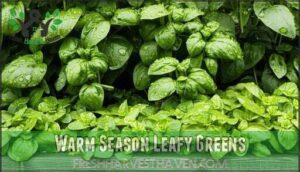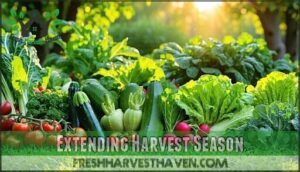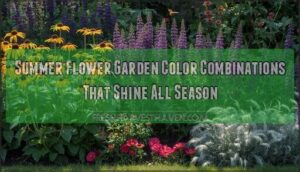This site is supported by our readers. We may earn a commission, at no cost to you, if you purchase through links.

Summer squash practically grows itself, while tomatoes pack your garden with fresh flavor and lycopene. Don’t overlook heat-tolerant leafy greens like Malabar spinach that won’t bolt in scorching weather.
Choose varieties suited to your climate and prepare well-draining soil enriched with compost. With proper timing and the right picks, your summer garden becomes a productivity powerhouse that keeps your kitchen stocked all season long.
Table Of Contents
- Key Takeaways
- Summer Vegetable Options
- Preparing Garden Soil
- Growing Summer Vegetables
- Warm Season Leafy Greens
- Extending Harvest Season
- Frequently Asked Questions (FAQs)
- What vegetables can you grow in summer?
- Do summer vegetables grow well in the Sun?
- Can you grow summer vegetables in your yard?
- Which vegetables grow best in the fall?
- Can you plant vegetables in July and August?
- Can you plant vegetables in hot summer?
- Can you grow vegetables in summer?
- What vegetables grow well in summer?
- What can I plant in my Garden in summer?
- What vegetables can you grow in winter?
- Conclusion
Key Takeaways
- You’ll succeed with heat-loving favorites like tomatoes, peppers, zucchini, and cucumbers that thrive in warm soil and deliver abundant harvests with minimal effort.
- You need to prepare well-draining soil enriched with compost and ensure your plants get 6-8 hours of full sun daily for optimal growth and fruit production.
- You can extend your harvest season by succession planting quick-maturing crops every 2-3 weeks and using protective methods like row covers for unexpected weather changes.
- You’ll maximize yields by choosing varieties suited to your specific climate and maintaining consistent watering schedules rather than frequent shallow watering that weakens root systems.
Summer Vegetable Options
Summer vegetables deliver fresh flavors and abundant harvests with surprisingly little effort required
You’ll find dozens of summer vegetables that thrive in warm weather and produce abundant harvests throughout the season. From quick-growing zucchini and cucumbers to heat-loving tomatoes and peppers, these crops offer fresh flavors and nutritional benefits for your table.
Easy-to-Grow Summer Vegetables Like Zucchini and Cucumbers
When you’re starting your summer vegetable garden, zucchini and cucumbers consistently rank as the most beginner-friendly options. These easy vegetables to grow in summer practically guarantee success with minimal effort and maximum reward.
Here’s why they’re perfect starter crops:
- Summer squash varieties – Zucchini produces abundantly with basic watering and full sun exposure
- Cucumber cultivation – Thrives with simple trellising and responds well to companion planting with herbs
- Low-maintenance growing – Both resist common problems while providing excellent harvesting tips opportunities
These summer vegetables offer reliable harvests with straightforward pest control needs.
Choosing Varieties for Climate and Region
Your local climate determines which summer vegetables will thrive in your garden. Heat-tolerant squash varieties excel in scorching regions, while local cucumber cultivars perform better than generic types. Consider microclimate considerations like soil drainage and wind exposure when selecting regional tomato types and climate-specific peppers. Consistent moisture and mulching are essential for growth of these vegetables.
Match your summer heat conditions with appropriate heat-tolerant varieties for guaranteed success.
| Region | Heat-Loving Vegetables | Summer Gardening Tips |
|---|---|---|
| Hot/Dry | Okra, Armenian cucumbers | Use shade cloth for greens |
| Humid | Malabar spinach, cowpeas | Choose mildew-resistant varieties |
| Cool Coastal | Fast-maturing beans, lettuce | Extend season with row covers |
Nutritional Value of Summer Vegetables for a Healthy Diet
Summer vegetables deliver outstanding nutritional benefits that boost your health naturally. Fresh produce from your garden provides essential vitamins and minerals while offering exceptional antioxidant benefits compared to store-bought options.
Cucumbers and zucchini serve as excellent hydration sources with low calorie density. Tomatoes pack lycopene for heart health. Leafy greens contribute significant fiber content for digestive wellness, making organic vegetables perfect additions to nutritious summer meals.
Many people also enjoy summer diet foods like berries and yogurt to stay healthy.
Preparing Garden Soil
You’ll need proper soil preparation before planting your summer vegetables to guarantee strong growth and maximum harvests.
Start by testing your soil pH and adding compost or aged manure to create the rich, well-draining foundation that heat-loving crops like tomatoes and peppers require.
Soil Requirements for Summer Vegetables Like Tomatoes and Peppers
Through decades of growing experience, proper soil preparation makes the difference between struggling plants and abundant harvests. Your tomatoes and peppers need rich soil with balanced nutrient needs and ideal soil pH between 6.0-7.0. Drainage importance can’t be overstated—waterlogged conditions kill roots quickly. Regular soil testing reveals exactly what your garden lacks. Consider using a tomato soil test for perfect results.
- Mix generous amounts of compost and organic matter into heavy clay soils
- Test soil pH annually using simple home testing kits
- Add organic amendments like aged manure to boost fertility naturally
Site Selection and Sunlight Needs for Optimal Growth
After preparing your soil, you’ll need the right location for your summer vegetable garden. Most heat lovers require full sun exposure for six to eight hours daily. Choose spots with excellent soil drainage to prevent waterlogged roots. Walk your yard and map microclimates—those sunny pockets and shaded areas that change throughout the day. Addressing issues can be done through various drainage products.
| Sunlight Needs | Best Vegetables | Space Optimization Tips |
|---|---|---|
| 8+ hours full sun | Tomatoes, peppers, eggplant | Use vertical trellises |
| 6-8 hours sun | Cucumbers, squash, beans | Plant in rows north-south |
| 4-6 hours sun | Leafy greens, herbs | Utilize container gardens |
| Partial shade | Lettuce, spinach, cilantro | Succession plant weekly |
Your garden layout matters more than you think. South-facing slopes warm faster and stay warmer longer.
Watering and Fertilizing Summer Vegetables for Maximum Yield
Transform your summer vegetable garden into a thriving powerhouse with smart watering frequency and fertilizer types. Water deeply twice weekly rather than daily shallow sprinkles to build strong roots and prevent blossom-end rot in tomatoes. Soil testing reveals what your plants actually need. Apply balanced fertilizer every three weeks, watching for nutrient deficiencies like yellowing leaves.
Optimal watering times are early morning or late afternoon. Your summer vegetables will reward consistent care with abundant harvests. These summer gardening tips guarantee maximum yields from your summer vegetable garden throughout the growing summer vegetables season.
Growing Summer Vegetables
You’ll find success with summer vegetables by choosing the right varieties for your climate and planting them at the proper time.
Focus on heat-loving crops like tomatoes, peppers, and squash that thrive in warm soil temperatures and full sun exposure.
Tips for Growing Zucchini and Summer Squash
Two simple tricks guarantee bumper zucchini and summer squash harvests. Start seeds when soil hits 70°F in full-sun spots with rich, well-draining earth. These summer vegetables need consistent water and occasional feeding.
Varieties like zucchini come in various colors and shapes. Harvest daily when fruits reach 6-8 inches to prevent powdery mildew and squash vine borers.
Companion planting with nasturtiums deters pests naturally. Proper harvesting techniques prevent blossom end rot.
Planting and Caring for Runner Beans and Peas
Runner beans and peas reward gardeners with abundant summer harvests when you master their specific needs. These climbing vegetables need sturdy bean trellising methods installed before planting. Set up 6-8 foot poles or wire frames to support their vigorous growth.
Start with proper soil preparation. Inoculate pea seeds with beneficial bacteria to boost nitrogen fixation and improve yields. Plant seeds directly in well-draining soil after the last frost date.
Watering techniques matter for healthy plants. Water deeply at soil level twice weekly rather than frequent shallow sprinkles. This prevents fungal diseases on leaves while encouraging strong root development.
Companion planting works wonders for pea pest control. Plant marigolds nearby to deter aphids naturally. Nasturtiums also repel common garden pests while attracting beneficial insects.
Monitor harvesting timing carefully for peak flavor:
- Pick pea pods when plump but tender
- Harvest runner beans every 2-3 days when young
- Regular picking encourages continued production
- Morning harvests offer best quality and crispness
- Stop harvesting once pods become tough or stringy
Growing Carrots and Radishes in Summer for a Bountiful Harvest
Summer sowing these root crops requires attention to timing and soil temperature. Carrots thrive in 55-65°F conditions while radishes handle warmer weather. Plant radish spacing at 1-2 inches apart with carrot varieties like ‘Little Finger’ spaced 2-3 inches. This companion planting provides natural pest control for your summer vegetables.
| Crop | Soil Temperature | Spacing |
|---|---|---|
| Carrots | 55-65°F ideal | 2-3 inches |
| Radishes | 40-65°F range | 1-2 inches |
| Both | Monitor for summer harvest | Mix together |
Warm Season Leafy Greens
You can grow heat-tolerant leafy greens throughout summer when traditional lettuce struggles in hot weather.
Try Malabar spinach and New Zealand spinach, which thrive in temperatures that would make regular greens bolt and turn bitter.
Lettuce and Other Leafy Greens for Salads and Sandwiches
Beat the summer heat with bolt-resistant lettuce varieties like buttercrunch and romaine. These heat tolerant lettuce options won’t bolt as quickly as regular types. Mix in sandwich-friendly greens like arugula and mizuna for crunch that lasts.
Growing baby greens works best—harvest young leaves before they turn bitter. Give your leafy vegetables morning shade and consistent water. Summer green care means picking early when leaves are tender and sweet.
For a continuous supply, consider successive planting strategies as well.
Planting and Caring for Rocket and Spinach
Your rocket and spinach don’t have to wilt under summer heat. Choose heat-tolerant rocket varieties and New Zealand spinach for better performance. These summer vegetables thrive with consistent moisture and partial shade during peak temperatures.
- Plant every 2-3 weeks for continuous harvests of fresh leafy vegetables
- Use shade cloth to prevent bolting and bitter leaves
- Apply organic mulch for pest control and moisture retention around plants
Growing Spring Onions in Summer for Fresh Flavor
While rocket and spinach handle summer heat well, spring onions offer even more flexibility for summer planting. You’ll find these summer vegetables incredibly rewarding since they mature quickly and provide continuous harvests.
Plant seeds directly in well-draining soil every 2-3 weeks for succession crops. These growing vegetables need consistent but light watering—soggy soil causes bulb rot. For pest control, use row covers against onion flies. Companion planting with carrots deters common pests naturally.
Summer gardening tips include harvesting young for mild flavor enhancement or letting bulbs develop for stronger taste. These summer gardening staples thrive in containers too.
Extending Harvest Season
You can keep your summer garden producing well into fall with smart planting strategies and proper timing. Plant quick-maturing crops like radishes and lettuce every two weeks and protect tender plants from early frost to extend your harvest window.
Tips for Growing in Containers for Small Spaces
Container gardening lets you grow summer vegetables anywhere. Small spaces don’t limit your harvest potential when you choose the right approach.
- Container size: Use pots 12+ inches deep for most summer vegetables
- Drainage solutions: Drill multiple holes to prevent waterlogged roots
- Vertical gardening: Stack planters or use trellises for climbing crops
- Growing bags: Lightweight fabric containers work well for balcony gardening
- Urban limitations: Position containers where they’ll get 6-8 hours of direct sunlight
Selecting the right container gardening supplies is key to success. Quality potting mix beats garden soil every time. Check moisture daily during hot weather for best results.
Protecting Plants From Frost and Extreme Weather
Weather doesn’t always cooperate with your summer gardening plans. Smart gardeners monitor forecasts and prepare frost protection methods before trouble strikes. Row covers and frost blankets shield tender plants when temperatures drop unexpectedly below 50°F. Shade cloth prevents heat stress during scorching days above 90°F. Frost blankets can help retain warmth.
| Weather Challenge | Protection Method | Application Timing |
|---|---|---|
| Late frost | Row covers, blankets | Deploy when temps drop below 50°F |
| Extreme heat | Shade cloth (30-50%) | Install during heat waves above 90°F |
| Hail storms | Protective netting | Set up before predicted storms |
Windbreak strategies using stakes support tall tomatoes and peppers. Hail protection netting saves crops from sudden storms. Heat-tolerant varieties handle summer gardening problems better than sensitive plants. Quick action prevents extreme weather damage to your harvest.
Sowing Successionally for Longer Harvest and Increased Yield
Successful summer gardening requires staggered planting every 2-3 weeks. This maximizing yield technique ensures a continuous harvest instead of an overwhelming abundance followed by empty beds. Smart gardeners practice crop rotation while extending production through strategic timing.
- Beans – Sow every 2 weeks for steady supplies
- Lettuce – Plant at 10-day intervals during cool mornings
- Radishes – Direct seed weekly for ongoing harvests
- Herbs – Replant cilantro and dill biweekly for fresh flavor
Frequently Asked Questions (FAQs)
What vegetables can you grow in summer?
Summer’s warmth unlocks your garden’s full potential. You can grow heat-loving tomatoes, peppers, cucumbers, zucchini, eggplant, okra, and melons. These sun-worshippers thrive in temperatures above 60°F and need consistent watering.
Do summer vegetables grow well in the Sun?
Yes, most summer vegetables thrive in full sun exposure. Tomatoes, peppers, cucumbers, and squash need at least eight hours of direct sunlight daily for ideal growth and fruit production.
Can you grow summer vegetables in your yard?
Like transforming a patch of earth into your personal Eden, you can absolutely grow summer vegetables in your yard. **Most homes offer enough space and sunlight for tomatoes, peppers, and cucumbers to flourish beautifully.
Which vegetables grow best in the fall?
Cool-season vegetables shine in fall gardens. You’ll have the best luck with carrots, radishes, beets, kale, spinach, lettuce, broccoli, and Brussels sprouts since they tolerate frost and cooler temperatures perfectly.
Can you plant vegetables in July and August?
July and August are perfect months for planting many vegetables. You can successfully grow root crops, greens, and other vegetables from July or August plantings.
Focus on quick-maturing varieties that’ll beat your first frost date.
Can you plant vegetables in hot summer?
Don’t let scorching heat fool you into thinking gardening’s impossible. You can definitely plant vegetables during hot summer months.
Heat-resistant vegetables like okra, sweet potatoes, peppers, and eggplants thrive in sweltering temperatures. Choose heat-tolerant varieties and you’ll harvest success.
Can you grow vegetables in summer?
You can absolutely grow vegetables in summer. Heat-loving crops like tomatoes, peppers, cucumbers, and squash thrive in summer’s warmth. Plant them when soil reaches 60-70°F for best results.
What vegetables grow well in summer?
Summer’s sizzling season suits several exceptional vegetables perfectly. These include tomatoes, peppers, cucumbers, zucchini, eggplant, and okra.
These heat-loving champions flourish in warm soil and sunshine, delivering fresh flavors for your table.
What can I plant in my Garden in summer?
Plant heat-loving crops like tomatoes, peppers, cucumbers, and summer squash in your garden. These thrive in warm soil and full sun.
You can also succession plant beans, corn, and quick-growing greens for continuous harvests throughout the season.
What vegetables can you grow in winter?
You can grow cold-hardy vegetables like kale, spinach, broccoli, carrots, beets, and Brussels sprouts in winter. These crops actually taste sweeter after frost hits them.
Conclusion
Success awaits when you choose the best summer vegetables to plant for your 2025 garden. These heat-loving crops reward minimal effort with maximum harvests. Start with easy winners like tomatoes and zucchini, then expand to leafy greens and beans.
Proper soil preparation and consistent watering guarantee thriving plants. You’ll enjoy fresh produce all season while building confidence for future growing adventures.
- https://bonnieplants.com/blogs/garden-fundamentals/ranking-vegetables-for-efficiency
- https://www.reddit.com/r/selfreliance/comments/1lmovks/article_14_best_summer_vegetables_to_grow/
- https://nevegetable.org/cultural-practices/estimating-vegetable-yields
- https://albopepper.com/how-much-vegetable-yield-do-vegetable-plants-produce.php
- https://fryd.app/en/magazine/yield-calculator-for-vegetables-calculate-area-requirements-and-harvest-quantities

